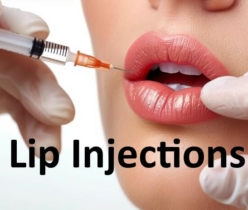A variety of techniques and augmentative fillers are available for lip augmentation, such as fat injections and grafting, hyaluronic acids, and AlloDerm. Techniques for lip augmentation include precise methods tailored to achieve natural-looking results. Our plastic surgeons are focused on performing lip augmentation and enhancement that are in harmony with a person’s facial features
Key Takeaways
- Various techniques exist for lip augmentation, including fat injections, hyaluronic acid fillers, and AlloDerm.
- Fat injections involve using the patient’s fat, offering a natural look but requiring more recovery time.
- Hyaluronic acid fillers are popular for their immediate results and minimal downtime.
- AlloDerm provides a longer-lasting solution but involves a more complex procedure.
- Consulting with a specialist is crucial to choosing the technique that best suits your facial features and aesthetic goals.
Fat Injections and Grafting

Procedure Overview
Fat grafting or fat injections to the lips involves removing fat from a patient’s own body and then injecting it into the lips. The fat is first lipo-suctioned, purified, and then carefully injected into the lips. This procedure typically takes 30 minutes to an hour. Employing atraumatic liposuction techniques in tandem with advanced fat processing methods is pivotal for enhancing graft survival.
Benefits and Risks
The primary benefit of fat injections is that it uses the patient’s tissue, reducing the risk of allergic reactions. Additionally, about 60 to 75 percent of the injected fat will stay permanently. However, not all of the fat cells will survive, and there may be swelling for several weeks. The strategic application of structural fat grafting principles, including layered microinjection techniques, ensures optimal vascularization and engraftment.
Recovery Time
Recovery time for fat injections can vary. Most patients experience swelling for several weeks. It’s important to follow post-procedure care instructions to ensure the best results. This procedure offers more natural-looking and long-lasting results, though recovery takes longer than other lip augmentation methods.
The art of lip augmentation through autologous fat transfer demands a sophisticated approach. Mastery of these techniques is indispensable for achieving seamless and enduring outcomes.
Hyaluronic Acid Fillers

Types of Hyaluronic Acid Fillers
The best fillers for injections are usually hyaluronic acid-based fillers which come in the form of gels. Some of the popular brands for hyaluronic acid fillers include Juvederm UltraPlus XC, Restylane, and Versa. Hyaluronic acid’s natural presence in the skin and lips makes these fillers effective.
Application Techniques
Hyaluronic acid, known for its hydrophilic properties, plays a central role in these fillers, contributing to tissue volumization by attracting and retaining water. Successful outcomes hinge on a comprehensive understanding of the complex vascular and neural networks in the perioral region, reducing the likelihood of complications such as vascular compromise.
Expected Results
The utilization of Hyaluronic Acid (HA) fillers offers an immediate and reversible avenue for lip augmentation. Characterized by minimal downtime, patients experience prompt results and have the flexibility to adjust outcomes using hyaluronidase if necessary. The diverse formulations cater to the precision required for targeting specific lip regions. Furthermore, the inherent low risk of complications makes HA fillers a popular choice for those seeking natural-looking results.
Lip filler with hyaluronic acid is a minimally invasive treatment that delivers natural results. Discover its benefits.
AlloDerm Lip Augmentation
What is AlloDerm?
AlloDerm regenerates tissues using a matrix derived from donated human skin. Processing removes cells, leaving a collagen matrix for reconstructive procedures like lip augmentation. This material integrates well with the body’s own tissues, providing a natural look and feel.
Procedure Steps
- Consultation with a specialist to determine suitability.
- Local anesthesia is administered to ensure comfort.
- Small incisions are made inside the mouth.
- AlloDerm is inserted and positioned to enhance lip volume.
- Incisions are closed with sutures.
Longevity and Maintenance
AlloDerm offers a semi-permanent solution for lip augmentation. While the results are long-lasting, they are not permanent and may require touch-ups over time. The body’s natural absorption of the material can vary, affecting the duration of the results. Regular follow-ups with your specialist are recommended to maintain the desired look.
AlloDerm provides a natural and effective option for those seeking a more permanent lip augmentation solution without the use of injectable facial fillers.
Linear Injection Techniques
Cannula vs. Needle
Another popular method of lip augmentation is the use of linear injections. Some specialists carry out this process with a cannula, while others prefer to use a needle. Learn why we consider linear threading the best lip filler technique for beginner injectors and other popular methods for achieving stunning results.
Procedure Details
The filler is injected parallel to the vermillion border. This method is relatively easy, but there are a few downsides. There may be some filler boluses prone to gel displacements along their borders, which can give the lips an unnatural look.
Safety Considerations
While linear injection techniques are generally safe, they can sometimes lead to undesired results, such as a ‘duck’ shape that diminishes the sharp edge for youthful appearances. It’s crucial to consult with a specialist to ensure the best outcome.
Linear injection techniques involve the filling of the vermillion borders, which may not be suitable for everyone.
Advanced Techniques for Lip Augmentation

Step-by-Step Φ Technique
The “step-by-step Φ” technique is designed to assist junior practitioners to simplify and senior practitioners to optimize their own lip augmentation procedure. This method has a short learning curve and it is easy and safe for even a resident plastic surgeon to master. The most challenging parts of lip augmentation are maintaining safety at all times and finding the right balance for natural-looking results.
Volumetric Augmentation
Volumetric augmentation defines specific points, enhancing the overall lip shape and pout. This technique offers targeted enhancement, allowing for meticulous control over lip aesthetics. For instance, the Vermilion Tubercle Accentuation technique involves the precise injection of dermal filler into the small elevations along the upper lip.
Cupid’s Bow Enhancement
Cupid’s Bow Enhancement focuses on defining the double-curve of the upper lip, creating a more youthful and aesthetically pleasing appearance. This technique often involves the use of hyaluronic acid fillers to achieve a natural look.
When considering advanced techniques for lip augmentation, it’s crucial to consult with a specialist to determine the most suitable method for your facial features and aesthetic goals.
Choosing the Right Technique
When considering lip augmentation, a consultation with a specialist is crucial. The specialist will evaluate your facial structure and discuss your aesthetic goals. This initial meeting helps in understanding the various techniques available and determining which one aligns best with your needs.
Several factors influence the choice of lip augmentation technique. These include:
- Facial symmetry: Ensuring a balanced appearance.
- Desired volume and shape.
- Longevity of results.
- Potential risks and recovery time.
A personalized treatment plan is essential for achieving the best results. This plan will be tailored to your unique facial features and aesthetic desires. The specialist may recommend a combination of techniques to ensure an ideal symmetry for a seamless look.
In the end, you want to ensure an ideal symmetry for a seamless look.
Conclusion
Lip augmentation offers a variety of techniques and fillers to enhance the appearance of lips, ranging from fat injections and grafting to hyaluronic acids and AlloDerm. We choose the best method based on your specific needs and desired outcomes, and each method offers unique benefits.
Whether opting for linear injection techniques or more sophisticated approaches like the “step-by-step Φ” technique, the goal remains the same: to achieve a natural, balanced, and aesthetically pleasing look that harmonizes with the individual’s facial features.
It is crucial to seek a qualified and experienced practitioner to ensure the best results and avoid any potential complications. With the right approach, lip augmentation can significantly enhance one’s appearance, boosting confidence and overall satisfaction.
Frequently Asked Questions
What are the most common techniques for lip augmentation?
The most common techniques for lip augmentation include fat injections and grafting, hyaluronic acid fillers, and AlloDerm. Each technique has its benefits and considerations.
How long do the results of hyaluronic acid fillers last?
The results of hyaluronic acid fillers typically last between 6 to 12 months, depending on the specific product used and individual factors such as metabolism and lifestyle.
What is the recovery time for fat injections and grafting?
Recovery time for fat injections and grafting can vary, but most patients can expect swelling and bruising to subside within 1 to 2 weeks. Full recovery may take a few months as the body adjusts to the new fat cells.
Are there any risks associated with lip augmentation procedures?
Lip augmentation, like any cosmetic procedure, carries risks of infection, asymmetry, and allergic reactions. It’s important to consult with a qualified specialist to minimize these risks.
What is the ‘step-by-step Φ’ technique in lip augmentation?
The ‘step-by-step Φ’ technique simplifies lip augmentation for beginners and optimizes it for experienced practitioners. It focuses on safety and achieving natural-looking results.
How do I choose the right lip augmentation technique for me?
Choosing the right lip augmentation technique involves consulting with a specialist who can assess your facial features, discuss your goals, and recommend a personalized treatment plan based on your needs and preferences.





